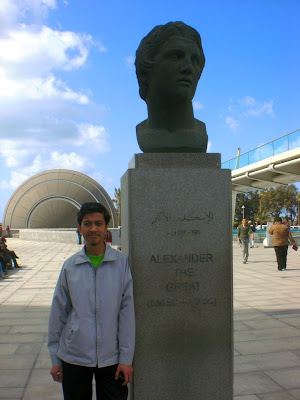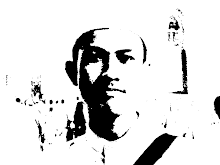Welcome to Alexandria: City of Dreams (مدينة ﭐلأحلام)

It’s my first time in Alexandria even though I’ve been living in Egypt for almost three years. It’s not easy to be there. So, once I got an invitation from my buddy to be there, I grabbed the chance to be in the city whose MP is from Muslim Brotherhood.
First Day: March 12th, 2009
I took a long-journey-cab from Mauqaf Talkha al-Jadīd in Al-Manṣūrah and began my three-hour journey to Alexandria. The fare was LE 13 for one-way trip. We passed Mahallah al-Kubra, Tanta, Kafr el-Zayat, Itay el-Baroud, Damanhour, Kafr al-Dawar and finally arrived at Alexandria. Those who want to go to Damanhour have no choice but to hop on this cab and full fare because there’s no direct cab from Al-Manṣūrah to Damanhour. I arrived at Mauqaf al-Jadīd at Alexandria outskirt on 7 o’clock.
I stayed at Che Mat’s house. He lives with Bakri, Aswad and Muhammad. Nur Izzat and Mohd Izzat, both second year medical students from University College Dublin who spent their Easter and St Patrick’s Day vacation was in Alexandria on the next day.
Second Day: March 13th, 2009
First place, we visited Montaza. It’s one of the rare beautiful garden and we got lucky because the flowers were blooming at that time. To get in here, we were charged for LE 6 per entrance. Inside, Montaza Palace is located and there are many rhubarb trees inside the park. There’s a myth about it: each tree represents a concubine of King Farouk. It’s ridiculous because there are too many
 Next, we moved to the nearest bay and watched the Mediterranean Sea. We attended the Friday prayer at a mosque opposite the Helnan Palestine Hotel. Then, we went to a seafood restaurant at Shatby nibbling (actually, devouring) seafood.
Next, we moved to the nearest bay and watched the Mediterranean Sea. We attended the Friday prayer at a mosque opposite the Helnan Palestine Hotel. Then, we went to a seafood restaurant at Shatby nibbling (actually, devouring) seafood.We visited Citadel of Qaitbay after taking a break in the afternoon. Unfortunately, we cannot enter the fort because it’s closed on 4 pm. However, we managed to visit the Maritime Museum at the fort. The fort was built during Sultan Al-Ashraf Sayf al-Din Qa'it Bay reign in 882 Hijra (1477 AC) on the The Pharos of Alexandria's ruin - one of The Wonders of the Ancient World. Some of the lighthouse remnants were incorporated into the wall of the fort.
At night, we went to Nabi Danial Street at Mansheya to visit the mausoleum of Prophet Danial (peace be upon him) and Luqman al-Hakim.
That marks the end of the visits for the day.
Third Day: March 14th, 2009
 On the second day, we first visited Bibliotheca Alexandrina. It was opened on 2002 near the old site of the Ancient Library of Alexandria - once the largest library in the ancient world. The Ancient Library of Alexandria was founded in 283 BC and it was where Archimedes invented his famous screw-shaped water pump. It was possibly burnt down to earth by Julius Caesar as part of his campaign to conquer Alexandria.
On the second day, we first visited Bibliotheca Alexandrina. It was opened on 2002 near the old site of the Ancient Library of Alexandria - once the largest library in the ancient world. The Ancient Library of Alexandria was founded in 283 BC and it was where Archimedes invented his famous screw-shaped water pump. It was possibly burnt down to earth by Julius Caesar as part of his campaign to conquer Alexandria. The library has seven floors arranged in terrace manner under one roof. It's not an ordinary library, perhaps, it is the only noisy library in the world! Its true function as a place to read has lost, being one of the tourist attraction spot in Egypt. Of course, you need a ticket to get in.
The library has seven floors arranged in terrace manner under one roof. It's not an ordinary library, perhaps, it is the only noisy library in the world! Its true function as a place to read has lost, being one of the tourist attraction spot in Egypt. Of course, you need a ticket to get in. The Manuscript and Rare Book Museum, located inside the library hosts some of the very rare historical exhibits such as The Book of The Dead, Kaabah's drape and Prophet Muhammad's letters to the rulers outside Arabian Peninsula. To get in, you need to pay for additional LE 2. And, no photographing allowed. But I managed to sneak in a camera and took some of the pictures inside. Here's some of the exhibits:
The Manuscript and Rare Book Museum, located inside the library hosts some of the very rare historical exhibits such as The Book of The Dead, Kaabah's drape and Prophet Muhammad's letters to the rulers outside Arabian Peninsula. To get in, you need to pay for additional LE 2. And, no photographing allowed. But I managed to sneak in a camera and took some of the pictures inside. Here's some of the exhibits: Ibn Sina’s Canon of Medicine; transcribed in 1761 AC
Ibn Sina’s Canon of Medicine; transcribed in 1761 AC Top right: Galen’s Sermo Adversus Empiricos Medicos (محنة ﭐلطيب ﭐلحاذق).
Top right: Galen’s Sermo Adversus Empiricos Medicos (محنة ﭐلطيب ﭐلحاذق).Top left: Paracelsus’ Alchemical Medicine (ﭐلطب ﭐلكميائي ﭐلجديد); translated into Arabic by Ibn Sallum al-Halaby (ﭐبن سلوم ﭐلحلبي).
Bottom right: Hippocrates’ Prognostics (تقدمة ﭐلمعرفة، لأبقراط).
 Top right: Prophet Muhammad’s (blessings and peace be upon him) letter to Heraclius.
Top right: Prophet Muhammad’s (blessings and peace be upon him) letter to Heraclius.Top left: Prophet's letter to Muqawqis.
Bottom right: Prophet's letter to Negus, King of Abyssinia.
Bottom left: Prophet's to Khosrau II of Persia.
Next, we roamed everywhere inside the library and even took a photo of Alexandria's Roman Shoreline from its roof!

And, before leaving the library, we took some photos to commemorate our moments there.

Later on, we had our lunch at Muhammad Ahmed restaurant. Just like any other Baghal Restaurant in Cairo and Al-Manṣūrah but this place boasts for being visited by Queen Sofia of Spain several years ago.
 al-Qāid Ibrahim Mosque
al-Qāid Ibrahim MosqueAfter the meal, we went to visit the Faculty of Medicine of Alexandria University. All of sudden, it started to rain. Then, we went our last destinations: El-Mursi Abul-Abbas Mosque and Sidi Yāqūt al-‘Arshi Mosque. Among the followers of Tareqah, these places is quite popular. It is where fourteen Sufis were entombed. Twelve of them are at Sidi Yāqūt al-‘Arshi Mosque.
 El-Mursi Abul-Abbas Mosque
El-Mursi Abul-Abbas MosqueThe current building of the mosque was designed by Italian architects in 1938. Before that, the mosque is already present since the 17th century. The mosque's name is taken after Ahmed Abul-Abbas El-Mursi Mosque, a disciple of Shazali Sufi and a theosopher from Murcia, Spain.
From the legends, it is known that Sidi Yāqūt got his nickname ‘al-‘Arshi’ because he was a muezzin that called for prayer (azan) simultaneously when the Arsh was calling for prayer as well.
With that location, that's the end for our trip in Alexandria. But, there's three locations I hope to visit in the future: Abu Darda's Mausoleum, Pompeii's pillar and Roman Amphitheater.
With that location, that's the end for our trip in Alexandria. But, there's three locations I hope to visit in the future: Abu Darda's Mausoleum, Pompeii's pillar and Roman Amphitheater.












